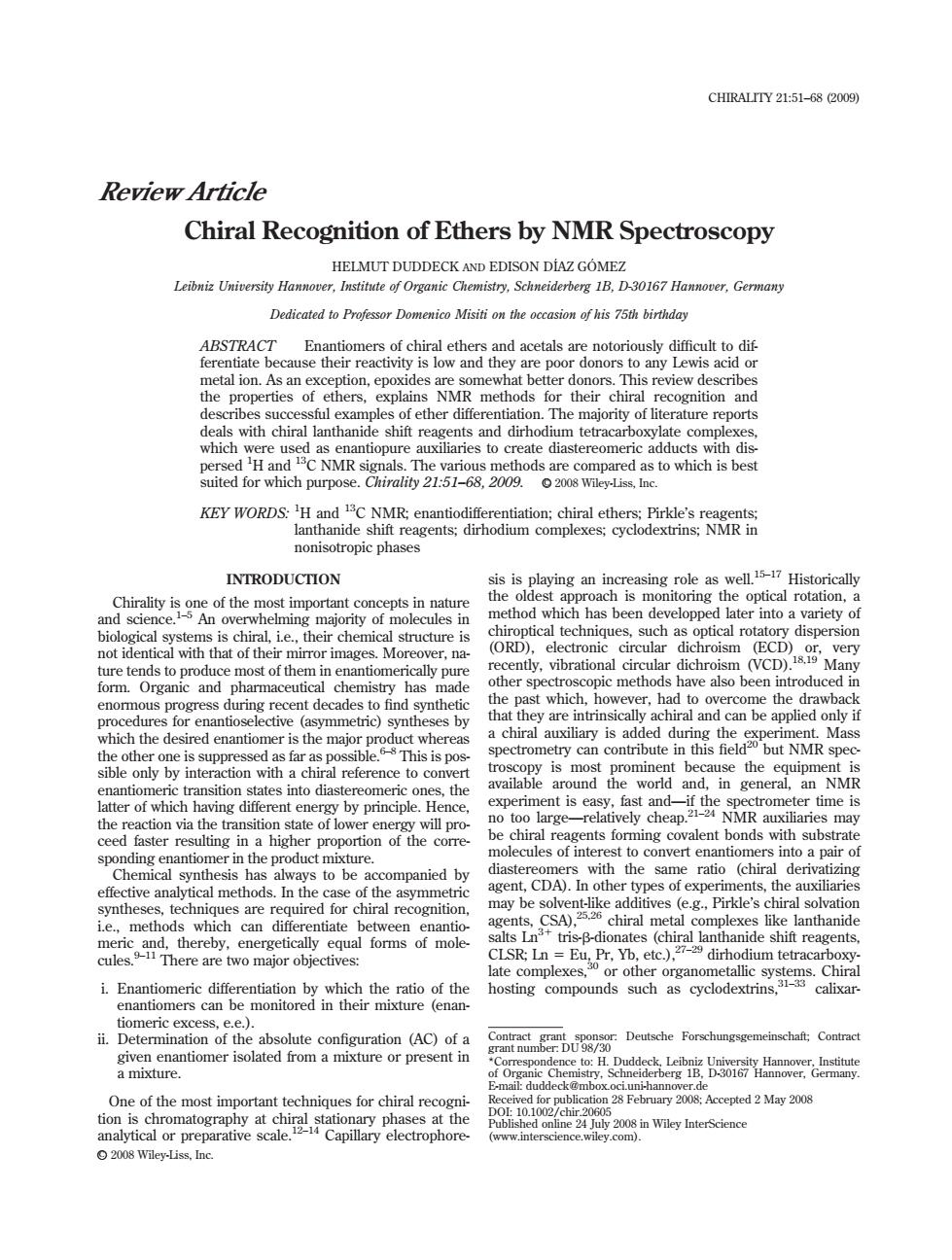正在加载图片...

CHIRALITY 21:51-68 (2009) Review Article Chiral Recognition of Ethers by NMR Spectroscopy HELMUT DUDDECK AND EDISON DIAZ GOMEZ Leibniz University Hannover.Institute of Organic Chemistry.Schneiderberg 1B.D-30167 Hannover.Germany rs of chiral eth are poc a ether difterer tion.The majority of literature reports re used a Rg吸。 antiopure s bes es:cyc INTRODUCTION sis is playing an increasing role as well5-17 Historically ue otical rot dis dich CD which the desired enantiomer is the majpr achiraland the other one is suppressed as far as possible.6Thsere his is pos sinto dias experiment is ea fast and time i the tate of ow en will pro- 道he ming covalent bonds with subst inte vert e nt a p Chemical is ha companied by ith ffe agent,CDA).I es of exp irkdle's les are re uired for chiral recognition chiral metal complex k lanthanid There are two major objectives: Determination of the absolute configuration (AC)of a gmnCngtiomerisolaledfioamamaureorpmesentn One of the most important techniques for chiral recogni- lor pu tion 28 February 2008;Accepted 2 May 2008 2008 Wiley-Liss.IncReview Article Chiral Recognition of Ethers by NMR Spectroscopy HELMUT DUDDECK AND EDISON DI´AZ GO´ MEZ Leibniz University Hannover, Institute of Organic Chemistry, Schneiderberg 1B, D-30167 Hannover, Germany Dedicated to Professor Domenico Misiti on the occasion of his 75th birthday ABSTRACT Enantiomers of chiral ethers and acetals are notoriously difficult to differentiate because their reactivity is low and they are poor donors to any Lewis acid or metal ion. As an exception, epoxides are somewhat better donors. This review describes the properties of ethers, explains NMR methods for their chiral recognition and describes successful examples of ether differentiation. The majority of literature reports deals with chiral lanthanide shift reagents and dirhodium tetracarboxylate complexes, which were used as enantiopure auxiliaries to create diastereomeric adducts with dispersed 1 H and 13C NMR signals. The various methods are compared as to which is best suited for which purpose. Chirality 21:51–68, 2009. VC 2008 Wiley-Liss, Inc. KEY WORDS: 1 H and 13C NMR; enantiodifferentiation; chiral ethers; Pirkle’s reagents; lanthanide shift reagents; dirhodium complexes; cyclodextrins; NMR in nonisotropic phases INTRODUCTION Chirality is one of the most important concepts in nature and science.1–5 An overwhelming majority of molecules in biological systems is chiral, i.e., their chemical structure is not identical with that of their mirror images. Moreover, nature tends to produce most of them in enantiomerically pure form. Organic and pharmaceutical chemistry has made enormous progress during recent decades to find synthetic procedures for enantioselective (asymmetric) syntheses by which the desired enantiomer is the major product whereas the other one is suppressed as far as possible.6–8 This is possible only by interaction with a chiral reference to convert enantiomeric transition states into diastereomeric ones, the latter of which having different energy by principle. Hence, the reaction via the transition state of lower energy will proceed faster resulting in a higher proportion of the corresponding enantiomer in the product mixture. Chemical synthesis has always to be accompanied by effective analytical methods. In the case of the asymmetric syntheses, techniques are required for chiral recognition, i.e., methods which can differentiate between enantiomeric and, thereby, energetically equal forms of molecules.9–11 There are two major objectives: i. Enantiomeric differentiation by which the ratio of the enantiomers can be monitored in their mixture (enantiomeric excess, e.e.). ii. Determination of the absolute configuration (AC) of a given enantiomer isolated from a mixture or present in a mixture. One of the most important techniques for chiral recognition is chromatography at chiral stationary phases at the analytical or preparative scale.12–14 Capillary electrophoresis is playing an increasing role as well.15–17 Historically the oldest approach is monitoring the optical rotation, a method which has been developped later into a variety of chiroptical techniques, such as optical rotatory dispersion (ORD), electronic circular dichroism (ECD) or, very recently, vibrational circular dichroism (VCD).18,19 Many other spectroscopic methods have also been introduced in the past which, however, had to overcome the drawback that they are intrinsically achiral and can be applied only if a chiral auxiliary is added during the experiment. Mass spectrometry can contribute in this field20 but NMR spectroscopy is most prominent because the equipment is available around the world and, in general, an NMR experiment is easy, fast and—if the spectrometer time is no too large—relatively cheap.21–24 NMR auxiliaries may be chiral reagents forming covalent bonds with substrate molecules of interest to convert enantiomers into a pair of diastereomers with the same ratio (chiral derivatizing agent, CDA). In other types of experiments, the auxiliaries may be solvent-like additives (e.g., Pirkle’s chiral solvation agents, CSA),25,26 chiral metal complexes like lanthanide salts Ln31 tris-b-dionates (chiral lanthanide shift reagents, CLSR; Ln 5 Eu, Pr, Yb, etc.),27–29 dirhodium tetracarboxylate complexes,30 or other organometallic systems. Chiral hosting compounds such as cyclodextrins,31–33 calixar- *Correspondence to: H. Duddeck, Leibniz University Hannover, Institute of Organic Chemistry, Schneiderberg 1B, D-30167 Hannover, Germany. E-mail: duddeck@mbox.oci.uni-hannover.de Contract grant sponsor: Deutsche Forschungsgemeinschaft; Contract grant number: DU 98/30 Received for publication 28 February 2008; Accepted 2 May 2008 DOI: 10.1002/chir.20605 Published online 24 July 2008 in Wiley InterScience (www.interscience.wiley.com). CHIRALITY 21:51–68 (2009) VC 2008 Wiley-Liss, Inc